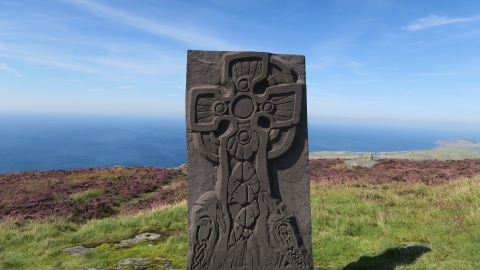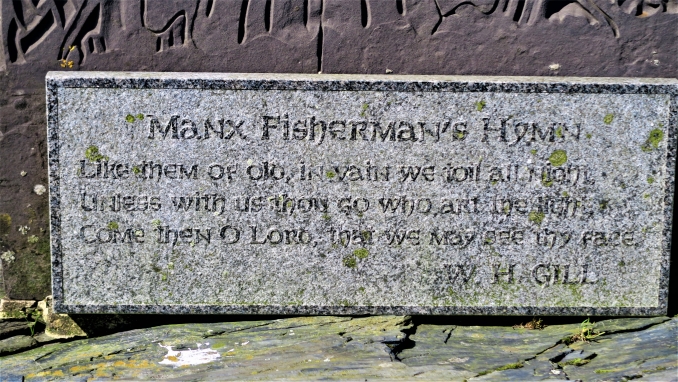Manx Celtic and Norse Cross on Cronk ny Arrey Laa

The Isle of Man (Manx: Mannin) has many sites of great archaeological significance that are quite remarkable for an island of approximately 33 miles long by 13 miles at its widest point. The earliest traces of humans on the Isle of Man can be traced back to the Mesolithic Period, after the ice sheets melted following the end of the last glacial period. In this part of Europe that would have been about 11,000 years ago. Small flint tools of stone or bone were used during this period some of which can be found in collections at the Manx Museum (Manx: Thie Tashtee Vannin).
Over the centuries people have left their mark on the Island. They include Iron Age hillforts and Bronze Age burial sites along with settlements from this period of history. There are stone circles, carved Celtic and Norse crosses, buried Viking ships and treasure, ancient Keeils (a Manx Gaelic word for a chapel), parish churches, castles and much more. The Manx people are quite rightly proud of their distinctive history, language and culture. One remarkable feature of this rich history are the many carved stone crosses found on the Isle of Man. The earliest stones carry Celtic designs and inscriptions using the early Celtic script called Ogham. Later Norse sculptors decorated their crosses with both Christian icons and images from their own pagan mythology. Many of these later crosses incorporated both Celtic and Norse designs as Viking settlers were assimilated into the existing Celtic community and spoke the native Gaelic language.
A number of new crosses replicating some of the design features of the original ones were carved and erected in the Manx Millenium in 1979. This was when the Manx people celebrated the millennium of their parliament Tynwald (Manx: Tinvaal), at over 1,000 years old, said to be the oldest continuous parliament in the world. One such was the Cross that stands on the hill of Cronk ny Arrey Laa on the southwest of the Island, although it could have been placed there some years after 1979. It incorporates both Manx Celtic and Norse designs. The name Cronk ny Arrey Laa when translated into English means Hill of the Day Watch. Which is said to be due to it having been used as a look out post during the time of the Viking invasions. The hill is also known locally as Cronk ny Irree-Laa, meaning hill of the rising day or dawn. It was said that when the sun rose over this hill, it was a sign for the herring-fishers to harvest their catch.
It is appropriate then that at the base of the cross is a section of "The Manx Fisherman's Evening Hymn". The words were written by Manx composer William Henry Gill (24 October 1839 - 27 June 1923). He also wrote the words to the Manx National Anthem: "Arrane Ashoonagh Dy Vannin". The inscription on the Cross reads:
"Like them of old, in vain we toil all night,
Unless with us Thou go, Who art the Light;
Come then, O Lord, that we may see Thy face."
The hymn in full is below with the first four verses being in the Manx Song Book in 1896. Verses 5 & 6 were added when requested by the editors of the Methodist Hymn Book, in 1904.
"The Manx Fisherman's Evening Hymn" by W. H. Gill.
HEAR us, O Lord, from Heaven, Thy dwelling-place;
Like them of old, in vain we toil all night,
Unless with us Thou go, Who art the Light;
Come then, O Lord, that we may see Thy face.
Thou, Lord, dost rule the raging of the sea;
When loud the storm, and furious is the gale,
Strong is Thine arm; our little barks are frail;
Send us Thy help; remember Galilee.
Our wives and children we commend to Thee;
For them we plough the land and plough the deep;
For them by day the golden corn we reap;
By night the silver harvest of the sea.
We thank Thee, Lord, for sunshine, dew and rain,
Broadcast from Heav'n by Thine almighty hand
Source of all life, unnumbered as the sand-
Bird, beast, and fish, herb, fruit, and golden grain.
O Bread of Life, Thou in Thy word hast said,
Who feeds in faith on Me shall never die!
In mercy hear Thy hungry children's cry,
Father, give us this day our daily bread!
Sow in our hearts the seeds of Thy dear love,
That we may reap contentment, joy, and peace;
Then, when at last our earthly labours cease,
Grant us to join Thy harvest home above.
Image above: Carved Cross on Cronk ny Arrey Laa
Image below: Inscription by W.H. Gill







